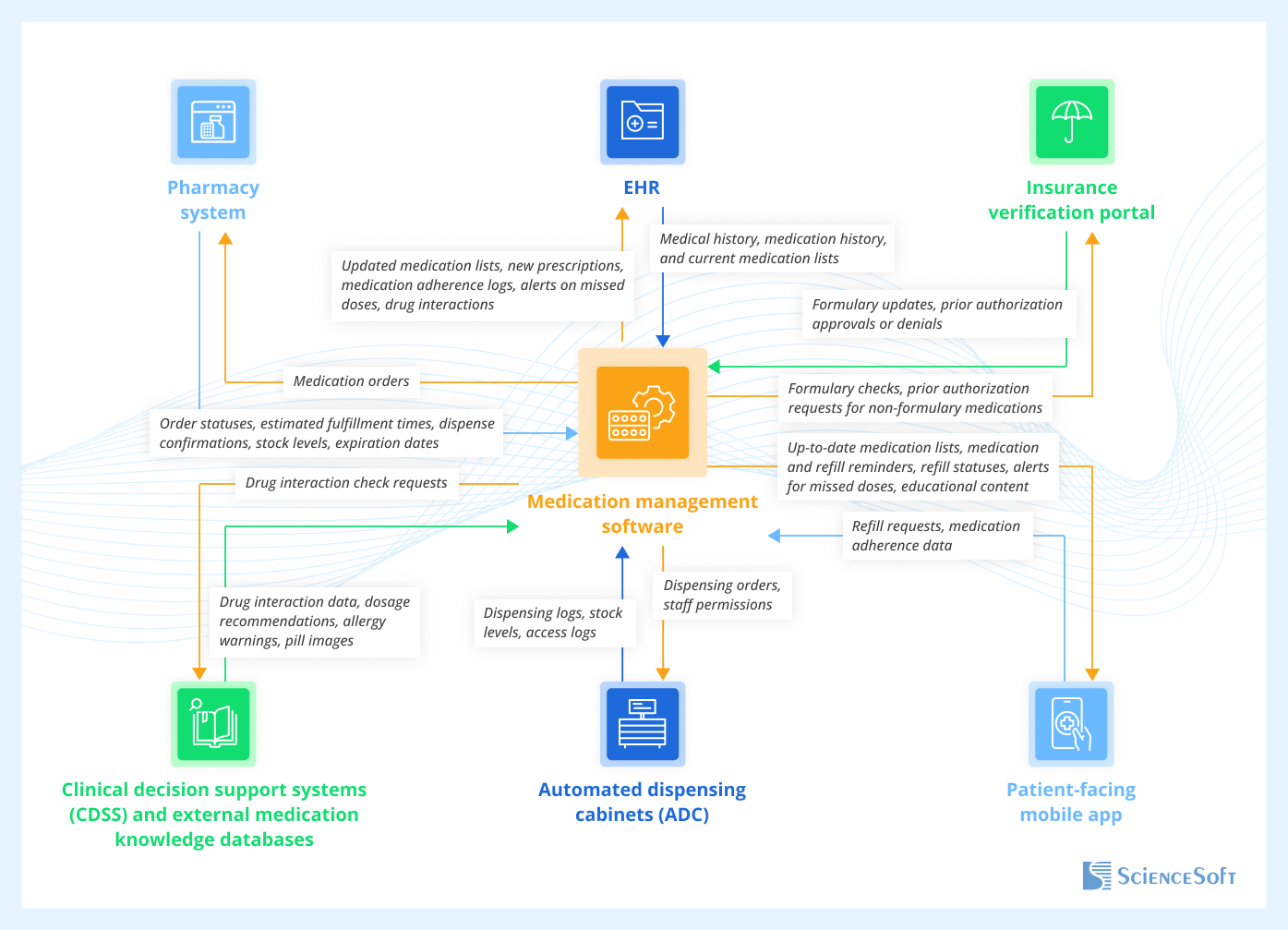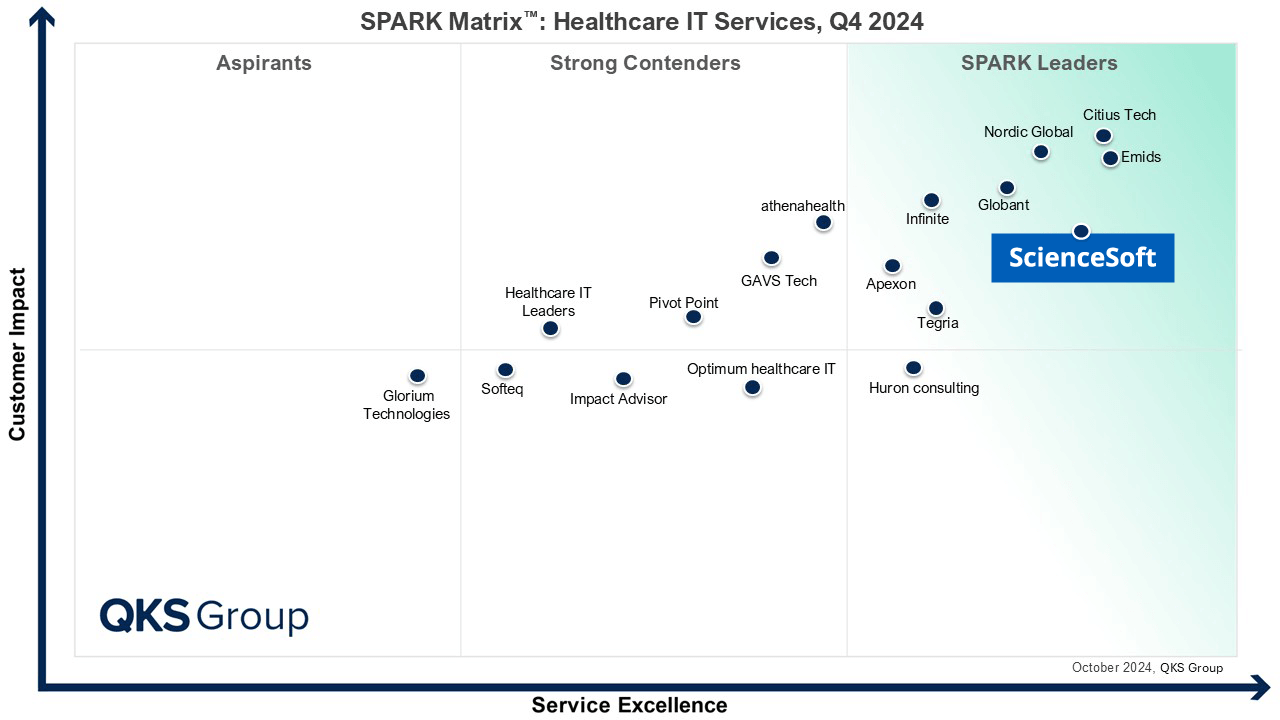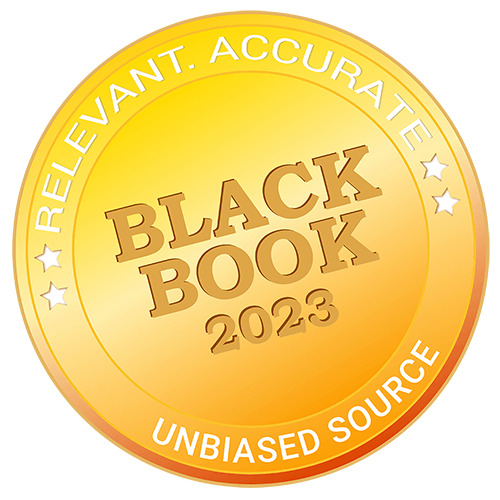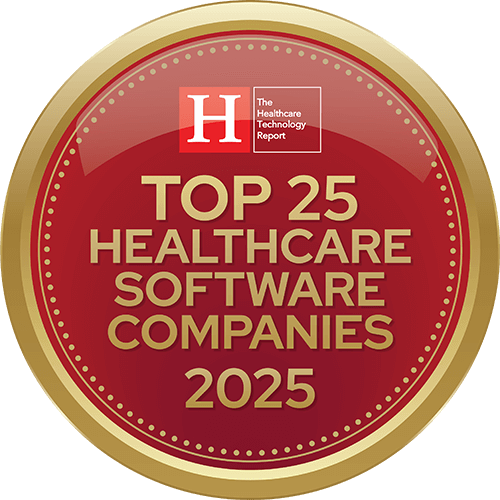Medication Management Software
Enhancing Patient Safety and Outcomes
In healthcare IT since 2005, ScienceSoft develops HIPAA-compliant custom medication management software that helps hospitals and long-term care facilities reduce medication errors and adverse medication events, automate unique medication management workflows, and improve treatment outcomes.
Medication Management Software: Essence
Medication management software helps hospitals, clinics, and long-term care facilities oversee and streamline the entire medication management process, from prescription to drug administration. By integrating intelligent medication safety checks (e.g., flagging drug interactions and allergies) and automated workflows (e.g., automated medication reconciliation), such systems can significantly reduce prescription error, minimize adverse effects, and track medication adherence, thus enhancing patient safety and outcomes. A custom medication management app will be ideal for healthcare organizations with unique medication management workflows, complex treatment protocols, or specific integration and compliance needs that off-the-shelf systems can't fully support.
Key features: patient electronic medication administration records (eMAR), e-prescribing, medication prescription decision support, medication reconciliation, and inventory management.
Key integrations: EHR/EMR, pharmacy software, medication knowledge database, insurance verification portal, automated dispensing cabinets (ADC), patient-facing mobile app.
Implementation time: from 5 to 8+ months for a basic solution, from 8 to 12+ months for an advanced system for a large hospital.
Development costs: developing a HIPAA-compliant custom medication management system with basic eMAR functionality will cost around $150,000 – $350,000, while a full-fledged HIPAA-compliant solution for a large hospital with eMAR, e-prescribing, barcode scanning, drug interaction and allergy alerts, and integrations with an EHR and a pharmacy system will cost approximately $800,000 – $2,500,000.
Development ROI: 70%–300%+ return over 3–5 years, depending on factors like adoption, training, workflow impact, software maintenance, and support expenses.
Key Features of Custom Medication Management Software
Below, ScienceSoft experts share medication management features commonly requested by our clients in the healthcare domain. These capabilities can be delivered as standalone systems (such as eMAR software for assisted living facilities), developed as integrated modules within an EHR system, or built as custom solutions that combine various aspects of medication management tailored to a healthcare organization's needs.
Integrations for Medication Management Software
Below, our experts provide a sample integration scheme for custom medication management software that includes capabilities like e-Prescribing, medication decision support, inventory tracking, medication dispensing management, and medication adherence tracking:

- EHR or EMR system — to automatically populate medication orders with a patient's information (e.g., name, condition); to get a consolidated view of a patient's medical history (diagnoses, lab results) when choosing medication; to check possible drug interactions or allergies in a patient's medical record; to import outpatient medication lists for reconciliation with the proposed inpatient medication; to update medication lists across EHR and medication management software in real time.
- Pharmacy system — to route medication orders to pharmacies; to monitor the dispensing and medication administration procedures; to check real-time inventory levels directly in medication management software.
- Clinical decision support systems and medication knowledge database (e.g., First Databank) — to access medication-related information (e.g., interactions, dosing guidelines); to perform automatic prescription checks and get alerts on drug interactions, allergic reactions, therapeutic duplications, etc.
- Insurance verification portal — to check if the prescribed meds are covered by the insurance and perform prior authorization if needed.
- Automated dispensing cabinets (ADC) — to sync the medication dispensing and stock level info between the ADC and the medication management system.
- Patient-facing mobile app — to monitor medication adherence; to support refill requests; to update medication lists in the patient app; to provide patients with education materials on drug administration; to enable direct messaging between patients and care providers.
Key Medication Management App Development Steps
Below, ScienceSoft experts outlined the key steps of custom medication management app development.
1.
Business analysis and requirements engineering
Business analysts study the organization's specific medication management workflows (e.g., prescribing, medication administration) and find out what systems the future solution should integrate with (e.g., an internal pharmacy system, an EHR system, e-Prescribing platforms). Business analysts also interview the medical staff who will use the system, including doctors, nurses and pharmacists, to identify core functional and non-functional requirements for the solution.
2.
Technical design
Software architects outline the custom medication management software's logical components (e.g., data flows, integration points with EHR and pharmacy systems) and then create detailed logical and functional architectural diagrams. The experts also decide on the tech stack that supports the solution's scalability, interoperability, and security requirements at the best cost-to-benefit ratio.
To accelerate project delivery, optimize development costs, and ensure compliance with regulations like HIPAA, architects can apply the industry-specific software design best practices like healthcare-specific Healthcare Industry Lens for the AWS Well-Architected Framework.
A custom medication management solution can be efficiently built using Microsoft Cloud for Healthcare. The platform accelerates development by offering HIPAA-compliant, ready-to-use tools for medication data integration, transformation, and secure storage. With pre-built FHIR APIs, you can seamlessly integrate the eMAR, e-prescribing, inventory management, and medication reconciliation features with existing EHRs and pharmacy systems. Azure Health Data Services and Microsoft Fabric provide a unified environment for storing clinical and medication data, enabling advanced analytics for adherence tracking, ADE analysis, and demand forecasting. Data exchange aligns with USCDI to support patient access and interoperability.
3.
UX and UI design
UX and UI designers focus on developing intuitive and accessible user interfaces tailored to the tasks of each user role (e.g., patients, nurses, and physicians). For instance, nurses using eMAR functionality may benefit from a minimalistic, distraction-free design that provides quick access to medication schedules and easy switching between different patient charts. Important information, such as alerts on missed doses and reminders about upcoming medication administration tasks, should be prominently displayed, color-coded based on urgency, and limited in quantity to avoid overwhelming nurses with excessive notifications.
Another important aspect that designers need to consider is making interfaces accessible for user groups who may have visual impairments, hearing loss, or motor difficulties. Medication management software should include accessibility features in line with Web Content Accessibility Guidelines 2.2 (WCAG 2.2). For example, accessibility features for visually impaired users may include high-contrast text, screen reader compatibility, keyboard navigation, and customizable font sizes.
4.
Software development and testing
ScienceSoft recommends taking the Agile approach to develop a custom medication management application in short iterations. That allows developers to enhance the solution's functionality and usability based on the feedback from future users (e.g., physicians and nurses) after each major iteration.
A good practice is to conduct functional, performance, usability, integration, and security testing in parallel with development to quickly reveal potential issues and prevent costly fixes at later stages.
5.
Deployment and support
At this stage, the development team configures the medication management software infrastructure, sets up data backup and recovery mechanisms, establishes robust network protection tools (e.g., SIEM), and deploys the solution. After the solution is set live, developers monitor its performance and fix any remaining issues. The team also prepares complete software documentation, including maintenance guides, instructions on API usage, and training materials for users.
Our awards, recognitions, and certifications

Featured among Healthcare IT Services Leaders in the 2022 and 2024 SPARK Matrix
Recognized for Healthcare Technology Leadership by Frost & Sullivan in 2023 and 2025
Named among America’s Fastest-Growing Companies by Financial Times, 4 years in a row

Top Healthcare IT Developer and Advisor by Black Book™ survey 2023
Recognized by Health Tech Newspaper awards for the third time (2022, 2023, 2025)

Named to The Healthcare Technology Report’s Top 25 Healthcare Software Companies of 2025
ISO 13485-certified quality management system
ISO 27001-certified security management system
Investments and ROI
The development costs of custom medication management software vary from $150,000 to $2,500,000, depending on its functionality, the number and complexity of integrations, and the chosen development approach.
Below, our healthcare experts provided some sample price ranges for custom medication management software development projects:
A HIPAA-compliant custom medication management app with basic eMAR functionality will cost around $150,000 – $350,000.
A full-fledged HIPAA-compliant medication management solution for a large hospital with eMAR, e-prescribing, barcode scanning, drug interaction/allergy alerts, and integration with EHR and pharmacy systems will cost around $800,000 – $2,500,000.
The expected ROI can reach 70%–300%+ return over 3–5 years, depending on factors like adoption, training, workflow impact, software maintenance, and support expenses.
Market-Available vs. Custom Medication Management Software
Below, ScienceSoft compares two popular out-of-the-box medication management systems with custom medication management software.
|
|
Medication Management Module of PointClickCare |
Epic Willow Inpatient Module of Epic EHR |
Custom Medication Management Solution |
|---|---|---|---|
|
Best for
|
Skilled nursing, assisted living, and other long-term care facilities that have standard medication management workflows. |
Hospitals that already use Epic software and have standard medication management workflows. |
Mid-size and large hospitals and long-term care facilities that have unique medication management workflows. |
|
Deployment type
|
Cloud-based. |
Cloud/on-premises. |
Cloud or on-premises, depending on your specific needs. |
|
Integrations
|
Native: with PointClickCare systems (e.g., PointClickCare EHR). Via API: with certain third-party systems (e.g., EHR systems of other providers, with open API and compatible data exchange standards). |
Native: with Epic systems (e.g., Epic EHR). Via API: with certain third-party systems (e.g., EHR systems of other providers, with open API and compatible data exchange standards). |
Smooth integration with any hospital or long-term care facility's internal systems (e.g., EHR, pharmacy inventory management systems), equipment (e.g., automated dispensing cabinets), and external systems (e.g., pharmacy systems), including legacy software. |
|
Core medication management functionality
?
E.g., eMAR, e-prescribing, barcode scanning, basic drug interaction checks, basic medication reconciliation tools. |
|
|
|
|
Extended medication management functionality
?
E.g., inventory and treatment analytics, advanced prescription checks, AI drug diversion detection, patient app, and prescription scanning, medication photos. |
|
|
|
|
Ownership
|
Vendor-owned. |
Vendor-owned. |
Fully owned by your organization. |
|
Ease of use
|
|
|
|
Why Choose ScienceSoft as Your Medication Management Software Development Partner
- Since 2005 in healthcare IT.
- ISO 13485, ISO 9001, and ISO 27001 certifications.
- Experience in achieving compliance with HIPAA, GDPR, and the 21st Century Cures Act requirements.
- Principal architects with experience building complex and secure solutions for the healthcare industry.
- In-house PMO with 40+ project managers holding PMP, PSM I, PSPO I, ICP-APM, and other certifications.





